Research
Research topics
The team’s goal is the development of new processes and technologies for a sustainable industry. In particular, the research aims to implement new innovative catalytic or organic products/processes in agreement with Green Chemistry and Circular Economy principles. In particular, the research is aimed at the implementation of innovative catalytic processes and the development of new organic compounds for different companies in the packaging, paints, tanning, fine chemistry sectors.
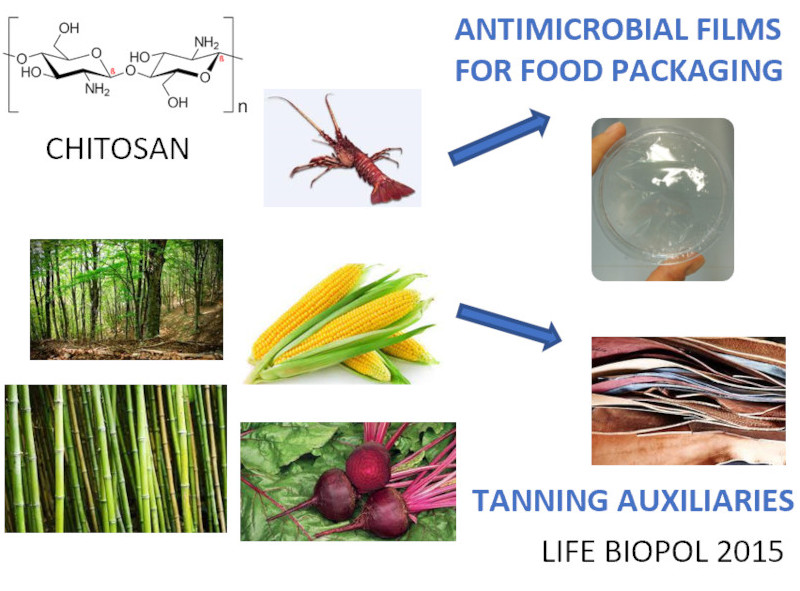
Recovery / recycling of agri-food waste for the tanning industry (BIOPOL)
Leather industry is one of the most polluting sectors in the world due to high carbon dioxide emissions, wastewater generation and large quantities of waste discarded in landfills.
In addition, it has been estimated that 15-18 m3 of water are required to process a ton of leather. Although it represents one of the most virtuous models of circular economy since the raw material is a waste from the food sector, tanning industry has a high environmental impact due to traditional tanning and retanning agents which are toxic to the environment and to health.
The main purpose of the LIFE BIOPOL project, directed by Codyeco S.p.A. in synergy with several industrial partners, was to implement a new technology that would allow the replacement of agents derived from non-renewable sources commonly used in the retanning phase.
The new retanning agents have been developed starting from agri-food biomass obtained as waste from relevant industrial processes, such as beet molasses and sugar cane molasses, both obtained from sugar refining processes.
Our research group performed the characterization of raw materials, intermediates and final products.by spectroscopic (NMR, FT-IR) and chromatographic (GPC) techniques.
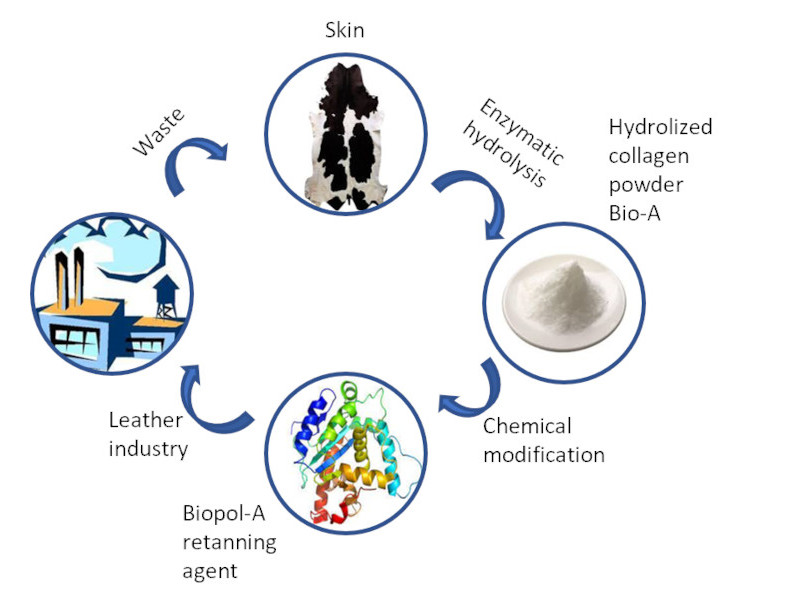
R. Sole, L. Taddei, C. Franceschi, V. Beghetto; Efficient Chemo-Enzymatic Transformation of Animal Biomass Waste for Eco-Friendly Leather Production, Molecule (2019) 24, 2979-2992
Bio-based film for highly biodegradable packaging
To reduce the environmental impact of plastics deriving from fossil fuels resources, the European Green Deal has recently emphasized the importance of the development and applicability of natural biopolymers. The global market for sustainable packaging is estimated to reach $ 51.2 billion in 2023. In this context, carboxymethylcellulose (CMC) and chitosan (CS) play a primary role in the design of new biomaterials for packaging. Thus, new formulations for eco-sustainable films based on CMC and CS were developed with the addition of a plasticizing agent and a cross-linking agent, which guarantee the obtainment of materials suitable for packaging. These new biomaterials have shown good mechanical properties and excellent barrier properties to water vapor and UV rays. Biodegradability tests showed complete degradation of all films in a time ranging from 15 to 21 days. All these characteristics make these bio-based films excellent candidates for applicability in the highly biodegradable packaging sector.
Further studies are underway to increase the performance of food packaging materials by anchoring antimicrobial molecules to CMC and CS. The improvement of the chemical-physical properties of the packaging and the increase of shelf life of the food will be verified.
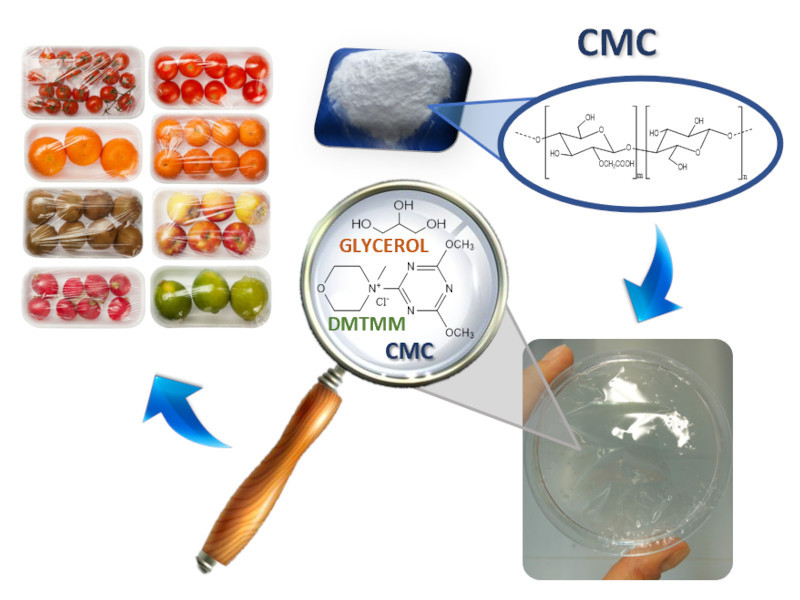
V. Beghetto, V. Gatto, S. Conca, N. Bardella, C. Buranello, G. Gasparetto, R. Sole Development of 4-(4,6-dimethoxy-1,3,5-triazin-2-yl)-4-methyl- morpholinium chloride cross-linked carboxymethyl cellulose films, Carbohydrate Polymers (2020) 249 116810-116820.
Recovery/recycling of end-of-life plastics for the production of high performance asphalt
Within the SARR project, it has been possible to develop a method for the recycling of waste of polyolefin as efficient additives to produce hot mix asphalt. This sinking fraction of polyolefin recycling is today a waste sent to incineration, in contrast to PE/PP mixed polyolefin which are sold as primary secondary materials for 0.45 €/kg for plastics production. Data achieved on laboratory scale, revealed that hot mix asphalt containing 4% by weight of waste of polyolefin had very high performance even superior to normal asphalt. Life Cycle Assessment (LCA) analysis is ongoing.
The technology is currently being developed to semi-industrial scale. Further studies will focus on the characterization and standardization of the plastics recovery process.
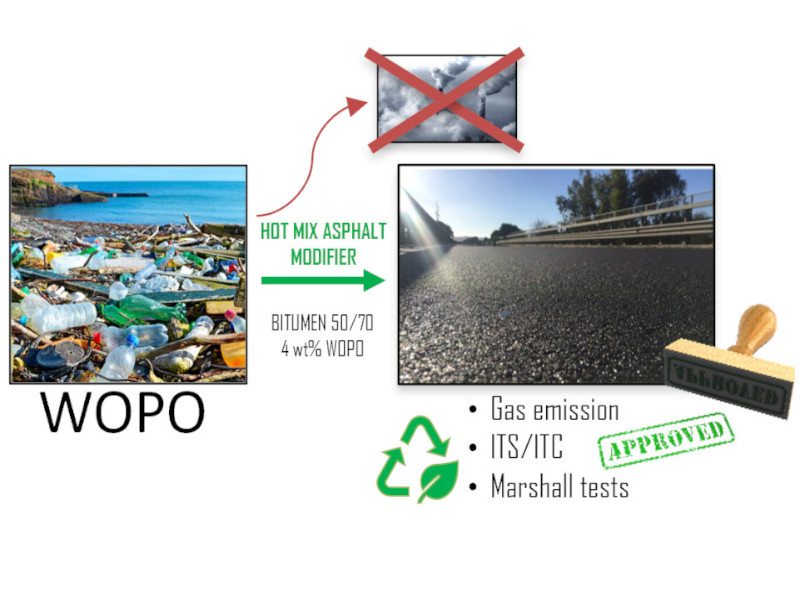
V. Beghetto, N. Bardella, R. Samiolo, V. Gatto, S. Conca, R. Sole, G. Molin, A. Gattolin, N. Ongaro; By-products from mechanical recycling of polyolefins improve hot mix asphalt performance, J Cleaner Production (2021) 318, 128627
Gypsum recovery/recycling for a Green building industry (sustainable living)
Plaster wall is currently one of the most used construction materials in light construction due to its speed of application and its special thermoacoustic, fire-retardant and water-repellent qualities. The enormous use of drywall, also due to the demographic increase, has led to the need to recover this material waste to decrease landfilling. This issue, within the SARR project, has led to the development of an effective plasterboard recovery method. The gypsum has been reused and enriched with TiO2, a cheap and easily available photocatalyst, able to degrade air pollution, concentrated mainly in indoor environments. To verify this performance, the modified gypsum has been subjected to a visual degradation test, in which a colored aqueous solution degrades as pollutant. During the project, the modified gypsum was also treated with a technology developed by Crossing srl to give anti-mold characteristics to the gypsum by coating deposition.
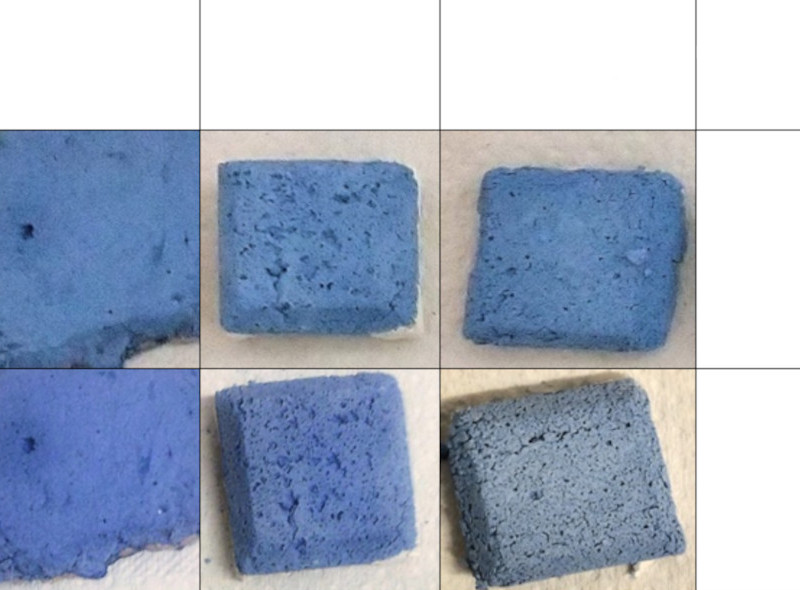
Extraction of flavonoids from soybean germ
The extraction of valuable compounds from industrial plant waste is a pivotal topic in the frame of circular economy and sustainability. Within the 3S-4H (Safe, Smart, Sustainable Food for Health) project, it was possible to develop a protocol that guaranteed the extraction of flavonoids from industrial waste of soybean germ. Flavonoids are a class of chemical compounds with excellent antioxidant and antiviral properties. The extraction of these substances was allowed by treating sample of soybean germ with hydroalcoholic mixture (ethanol, isopropanol) via Soxhlet extraction method. Different concentrations, temperatures and extraction times have been tested in order to optimize the extraction protocol. The extracted mixtures were then analyzed by FT-IR , 1H-NMR and 13C-NMR spectroscopies. Results acquired showed that the different extraction methods lead to the obtaining of different mixtures of extracted substances, which were then characterized in collaboration with UniPd by HPLC-MS for a more precise qualitative analysis.
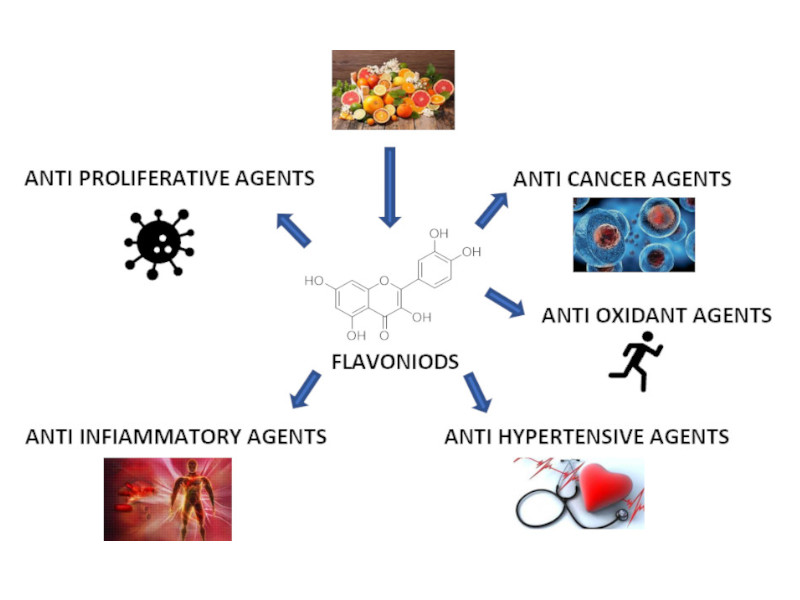
Extraction of terpenes from medicinal plants
Terpenes are a large class of organic compounds found in nature. They are the main components of plant resin and essential oils extracted from plants. In particular, monoterpenes are known for their anti-parasitic properties since they are toxic to a wide range of insects. For this reason, monoterpenes are important building blocks for the agro-chemical sector. This in mind, within the 3S-4H project (Safe, Smart, Sustainable Food for Health) it was possible to characterize extracts of medicinal plants such as sage, rosemary and thyme, using FT-IR, 1H-NMR and GC- MS. Each of these extracts highlighted the presence of various types of terpenes, in particular monoterpenes such as limonene, camphene and eucalyptol. Within the same project it was then possible to characterize horse chestnut extracts. Tests performed on these extracts have shown the presence of saponins, a group of organic substances known for their expectorant and anti-inflammatory properties.
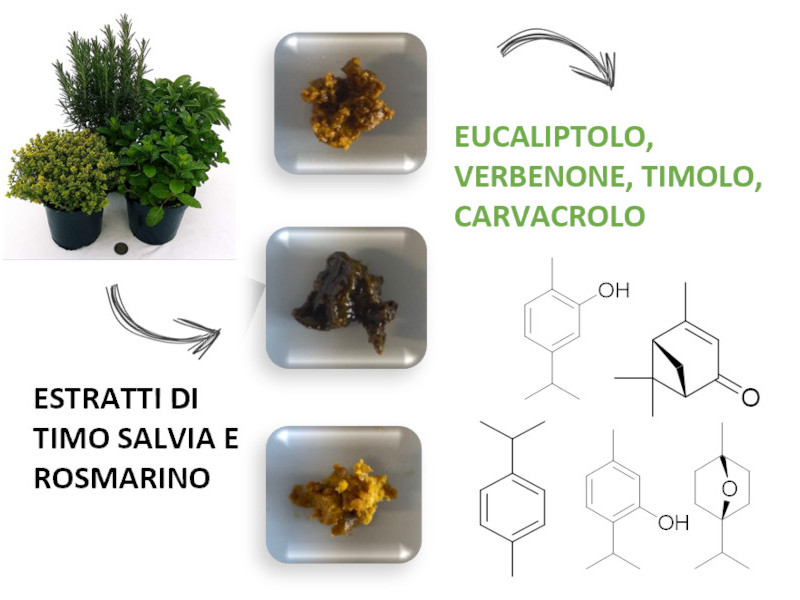
Homogeneous and heterogeneous catalysis studies
Sustainable chemistry necessarily requires the development of catalytic systems capable of reducing the energy consumption of chemical processes at the same time increasing their flexibility and selectivity. The group's research is focused on the development of new synthetic methods for the production of intermediates and products for fine chemicals. The "target" molecules are: intermediates, monomers, agrochemicals, fragrances, aromas. The main studied reactions are: hydrogenation, hydroformylation, carbonylation, cross-coupling reactions, "click chemistry" reactions. Since many of the target molecules are chiral, among the reactions studied there are also the enantioselective hydrogenation of C=C or C=O double bonds. Special attention is paid to the environmental aspects associated with homogeneous catalysis: in particular, "on water" or heterogenized reactions in water/organic solvent systems are studied. Reactions in an aqueous environment are also carried out using heterogeneous biogenerated and nanostructured catalysts obtained from fermentation processes of some microorganisms in the presence of metals, in particular metals recovered from exhausted catalytic converters and from waste from the processing of electrical and electronic materials (RAEE).
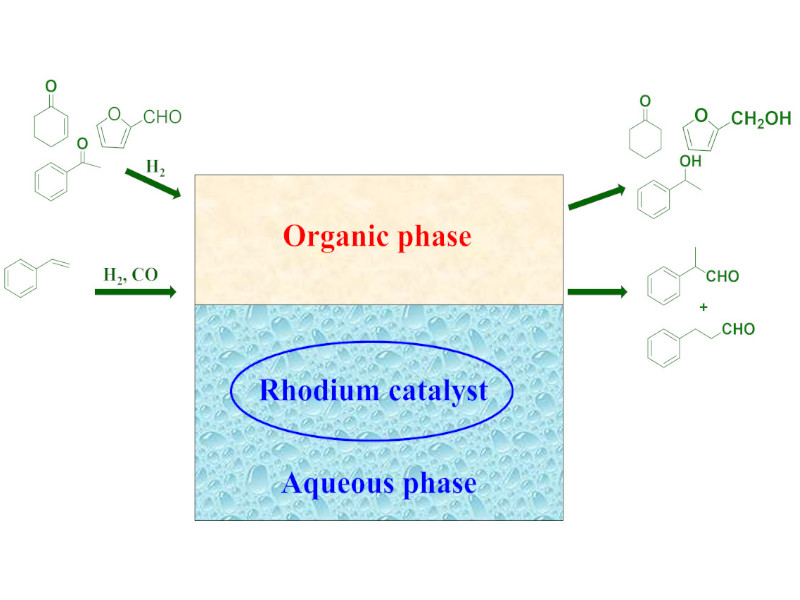
In order to carry out more sustainable processes, new heterogeneous nanostructured mono and bimetallic low metal content catalysts such as 0.3% Pd/Al2O3, Pd-Cu/Al2O3 (0.3% Pd and 0.7% Cu) and 0.3% Ni/Al2O3 were prepared and applied in hydrogenation reactions for the preparation of intermediates of Fine Chemistry compounds. Interesting results were obtained in the stereoselective semi-hydrogenation of 3-hexine-1-ol to (Z) -3 hex-1-ol, an important fragrance with herbaceous notes.
O. Piccolo, S. Paganelli, V.D. Rathod; Selective reduction of halo-nitro aromatic compounds using [Rh(DHTANa], a water soluble [Rh]-thioligand complex, Catalysis Communications (2016) 84 52-55
O. Piccolo, S. Paganelli, P. Zanatta, S. Tieuli, L. Sperni, F. Baldi, M. Gallo, I. Arčon, K. Vogel-Mikuš; A biogenerated polymetallic catalyst from society's wastes, Chemical Science International Journal (2019) 27, 1-12.
S. Paganelli, R. Tassini, V.D. Rathod, B. Onida, S. Fiorilli, O. Piccolo; A Low Rhodium Content Smart Catalyst for Hydrogenation and Hydroformylation Reactions, Catal. Letters (2021) 151, 1508-1521
A Smart Heterogeneous Catalyst for Efficient, Chemo- and Stereoselective Hydrogenation of 3-Hexyn-1-ol
S. Paganelli, A. Angi, N. Pajer, O. Piccolo; A Smart Heterogeneous Catalyst for Efficient, Chemo- and Stereoselective Hydrogenation of 3-Hexyn-1-ol, Catalysts (2021) 11, 14
Product/Process Implementation for a Sustainable Manufacturing
Further projects related to the sustainability of process/ product are carried out by Spin Off and Innovative PMI Crossing s.r.l. and concern the development of new reagents of "cross-linking activators" or "ACL". These compounds are capable of cross-linking a variety of materials of natural and/or synthetic origin without leaving a trace in the finished product. In this way you can obtain products and production processes with high sustainability for the production of:
- antimicrobial packaging,
- new generation preservatives/antibacterials
- anti-fouling paints and varnishes
- hydrophobic/hydrophilic surface treatments
- high performance bioplastics for packaging production
- non-toxic leather, "metal free"
These research topics are developed in partnership with national and international companies in order to promote high education and technology transfer.
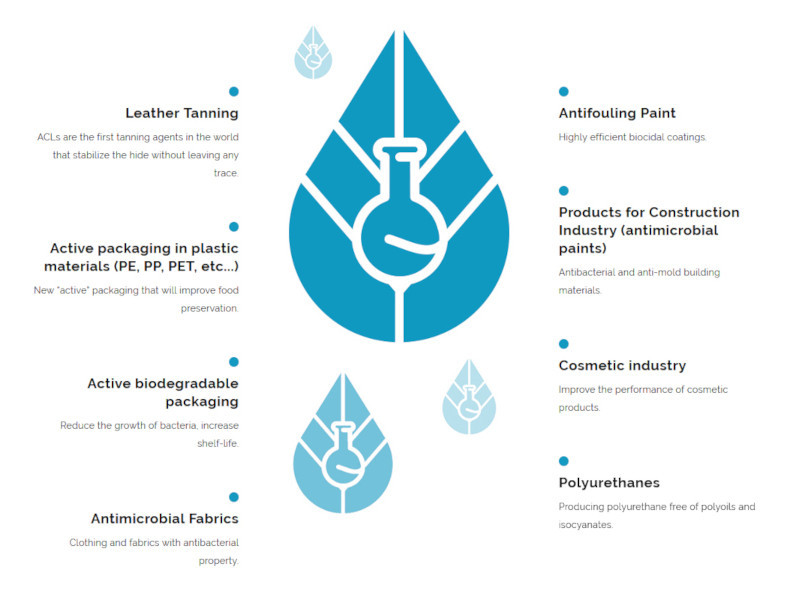
Funded Projects since 2018
European Funding

LIFE15 ENV/IT/000654 - LIFE BIOPOL – Production of Leather making BioPolymers from biomasses and industrial by products, through Life Cycle Designed processes
Project budget: € 3.879.018,0
Requested contribution: € 2,327,410.8
UNIVE share: € 191,716
Start of the project: 09/2016
End of the project: 09/2019
National Funding
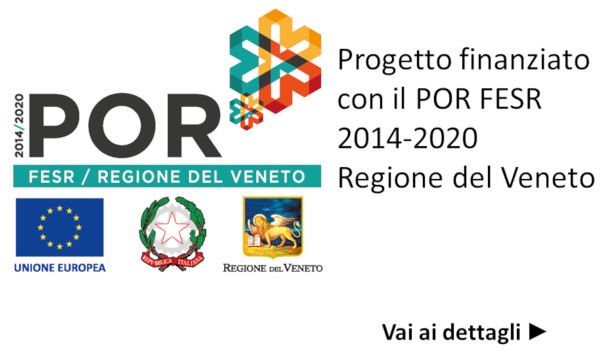
Ecodesign and recycling of PPE in a circular industrial chain – ECO-DPI
Regione del Veneto - POR FESR 2014-2020. Bando per il sostegno a progetti di Ricerca e Sviluppo realizzati dalle Reti Innovative Regionali e dai Distretti Industriali. ASSE 1 “RICERCA, SVILUPPO TECNOLOGICO E INNOVAZIONE” AZIONE 1.1.4 “Sostegno alle attività collaborative di R&S per lo sviluppo di nuove tecnologie sostenibili, di nuovi prodotti e servizi” DGR n. 822 del 23 giugno 2020
Project budget: € 2.999.460,00
Requested contribution: € 2.029.972,00
UNIVE share: € 200.000,00
Start of the project: 10/09/2020
End of the project: 30/12/2022
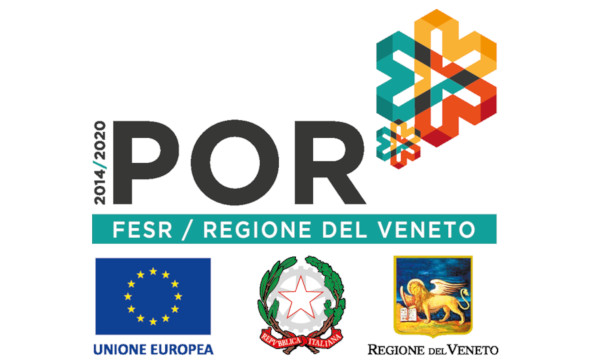
SAFE: Smart creAtivity for saFety and rEstart (SAFE)
Regione del Veneto - POR FESR 2014-2020. Bando per il sostegno a progetti di Ricerca e Sviluppo realizzati dalle Reti Innovative Regionali e dai Distretti Industriali. ASSE 1 “RICERCA, SVILUPPO TECNOLOGICO E INNOVAZIONE” AZIONE 1.1.4 “Sostegno alle attività collaborative di R&S per lo sviluppo di nuove tecnologie sostenibili, di nuovi prodotti e servizi” DGR n. 822 del 23 giugno 2020
Project budget: € 2,999,206.25
UNIVE share: € 55.000,00
Start of the project: 10/09/2020
End of the project: 31/12/2022

"Agriculture of the future and functional foods: a challenge for research and revitalization of the Venetian territory” (F.A.&A.F.)
Regione del Veneto - POR FESR 2014-2020. Bando per il sostegno a progetti di Ricerca e Sviluppo realizzati dalle Reti Innovative Regionali e dai Distretti Industriali. Asse 1. Azione 1.1.4 " Bando per contributi a sostegno alle attività collaborative di Ricerca & Sviluppo per lo sviluppo di nuove tecnologie sostenibili, di nuovi prodotti e servizi realizzati dalle Reti Innovative e dai Distretti Industriali
Project budget: € 3.000.000,00
UNIVE share: € 52.393,75
Start of the project: 10/09/2020
End of the project: 30/12/2022

PROGETTO 3S_4H Smart food for a sustainable future (3S_4H – Safe, Smart, Sustainable Food for Health) (POR FESR 3S-4H)
Regione del Veneto - POR FESR 2014-2020. Bando per il sostegno a progetti di Ricerca e Sviluppo sviluppati dai Distretti Industriali e dalle Reti Innovative Regionali ASSE 1 “RICERCA, SVILUPPO TECNOLOGICO E INNOVAZIONE” AZIONE 1.1.4 “Sostegno alle attività collaborative di R&S per lo sviluppo di nuove tecnologie sostenibili, di nuovi prodotti e servizi”. DGR n. 1139 del 19 luglio 2017
Project budget: € 5.188.650,00
Requested contribution: € 2.797.600,00
UNIVE share: € 280.000,00
Start of the project: 07/11/2017
End of the project: 31/06/2021

ADVANCED WASTE RECOVERY SYSTEMS – SARR (POR-FESR SARR)
Regione del Veneto - POR FESR 2014-2020. Bando per il sostegno a progetti di Ricerca e Sviluppo sviluppati dai Distretti Industriali e dalle Reti Innovative Regionali ASSE 1 “RICERCA, SVILUPPO TECNOLOGICO E INNOVAZIONE” AZIONE 1.1.4 “Sostegno alle attività collaborative di R&S per lo sviluppo di nuove tecnologie sostenibili, di nuovi prodotti e servizi”. DGR n. 1139 del 19 luglio 2017
Project budget: € 4.441.236,05
Requested contribution: € 2.572.970,62
UNIVE share: € 406.600,00
Start of the project: 07/11/2017
End of the project: 31/03/2021

Development of an innovative system for continuous Sanitization of fabrics, without consumption (Por-Fesr Lafer)
POR FESR 2014/2020 Bando per il sostegno a progetti sviluppati da aggregazioni di imprese ASSE 1 “RICERCA, SVILUPPO TECNOLOGICO E INNOVAZIONE” e ASSE 3 “COMPETITIVITÀ DEI SISTEMI PRODUTTIVI” AZIONE 1.1.4 “Sostegno alle attività collaborative di R&S per lo sviluppo di nuove tecnologie sostenibili, di nuovi prodotti e servizi”
Project budget: € 124.000,00
UNIVE share: € 30.000,00
Start of the project: 21/07/2017
End of the project: 21/09/2018
Crossing Funded Projects
Ecodesign and recycling of PPE in a circular industrial chain (EcoDPI)
POR FESR 2014-2020 Regione Veneto – Anno 2020 Asse 1 Azione 1.1.4 – DGR n.822 del 23 giugno 2020. Azione 1.1.4 “Sostegno alle attività collaborative di R&S per lo sviluppo di nuove tecnologie sostenibili, di nuovi prodotti e servizi” RETE INNOVATIVA REGIONALE proponente il progetto: VENETO GREEN CLUSTER
Innovative tanning agents for the production of highly stabilized leather
bando brevetti + 2019 – Decreto Direttoriale 26 Novembre 2019 – Asse III – Competitività PMI. Enhancement project for our italin pattent.
Project duration: dal 01/02/2020 al 31/07/2021
Advanced Waste Recovery Systems – SARR
POR FESR 2014-2020 Regione Veneto – Anno 2017 Asse 1 Azione 1.1.4. Azione 1.1.4 “Sostegno alle attività collaborative di R&S per lo sviluppo di nuove tecnologie sostenibili, di nuovi prodotti e servizi” RETE INNOVATIVA REGIONALE proponente il progetto: VENETO GREEN CLUSTER (riconosciuta con DGR n. 54 del 27/01/2017)
Implementation of high sustainability active packaging
POR FESR 2014-2020 Regione Veneto – Anno 2017 Asse 1 Azione 1.1.2 “Sostegno per l’acquisto di servizi per l’innovazione tecnologica, strategica, organizzativa e commerciale delle imprese”
Industrial research for the development of new tanning agents
POR FESR 2014-2020 Regione Veneto – Anno 2017 Asse 1 Azione 1.1.1 “Sostegno a progetti di ricerca alle imprese che prevedono l’impiego di ricercatori (dottori di ricerca e laureati magistrali con profili tecnico-scientifici) presso le imprese stesse”
Development of new green reagents for a sustainable tanning industry
POR FESR 2014-2020 Regione Veneto – Anno 2016 Asse 1. Azione 1.4.1b per il sostegno alla creazione e consolidamento di Start Up innovative ad alta intensità di applicazione di conoscenza e alle iniziative di Spin Off della Ricerca sub Azione B- Consolidamento Start Regione Veneto ID 10004342
